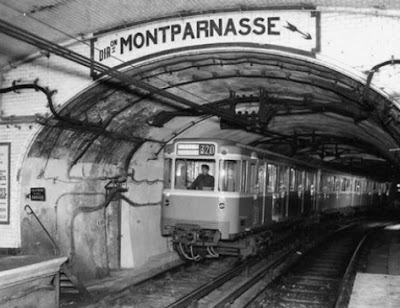Parallèlement au développement de la Compagnie du Chemin de Fer métropolitain (CMP), une autre concession est attribuée à la Société Berlier-Janicot qui réalise son propre réseau la compagnie du "Nord Sud". Cette compagnie exploitait un tronçon équivalent aujourd'hui aux lignes 12 et 13. Le Nord Sud finira par être absorbée en 1930 par la CMP.
The Nord Sud company's new line was, in part, in competition with CMP line 4 and its stations did have a distinctive style. Walls were tiled, as were station names.Enamel signs were fitted above the station exit tunnels confirming the direction of trains leaving that way.
What became Metro Line 12 also began by linking two of Portes of old Paris. In the south west the terminus was Porte de Versailles ...
... which had opened a few years earlier. The line opened in stages from 1910 to 1912.
... caused such a kerfuffle that high buildings were banned in the city.
In 1934 the line was extended two stops to Mairie d'Issy. (click on the graphic for a larger view)Here the Mairie is traditionally grand ...... and the Metro entrance is traditionally modest.The "Metro" signs are traditionally "Maigret"!Sigh! They don't make telly programmes like that any more!
In the north the line originally terminated at Porte de la Chappelle.Again, note the distinctive but minimalist Metro entrance.In December 2012, the line was extended one stop to "Front Populaire" ...
The line is being extended currently by two stops ...... not huge by today's extensive Parisian plans.The first new stop is "Aime Cesaire" ...Aimé Fernand David Césaire (26 June 1913 to 17 April 2008) was a French Martinican poet, author, and politician. He was "one of the founders of the Négritude movement in Francophone literature" and coined the word négritude in French. He founded the Parti progressiste martiniquais in 1958, and served in the French National Assembly from 1958 to 1993 and as President of the Regional Council of Martinique from 1983 to 1988.
Streetview passed by when construction of the station was in full swing ...... and the surrounding area is not the most picturesque in Paris. But there is a little open space near the new station which also carries the writer's name.
pre-opening pictures show something much grander that the usual Metro entrance with wide stairways ...... and lots of shiny stuff!
The waterway running across the aerial view is Canal Saint Denis which links into the River Seine at its northern end. It was, and still is, very industrial but, understandably, now in decline.The new M12 terminus will be at the Mairie d'Aubervilliers ...... a bit plain as Mairies go! A working site is directly opposite.There used to be trams here ...... and the Mairie has had a significant make-over!The line is due to open later this year having been delayed by, fbb understands, a nasty virus. For fbb, there are too many stations with "Aubervilliers" in their name! Some sources add Aubervilliers to the original terminus of Front Populaire which makes six.Thick lines on the map are RER and other "proper train" routes. Thinner lines are the Metro. Thin lines with square dots are trams. And, for those who like geographical maps below is an extract from an RATP "Sector" map showing everything with wheels, all streets and all bus stops.The extension is not yet shown, but the Aime Cesaire stop is near the "Felix Faure Victor Hugo" bus stop, centre right.Tomorrow we begin to look at the other extensions most of which are not yet under construction.
Next Vive La Difference blog : Thurs 31 March























































